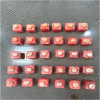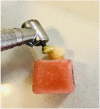Evaluation of the microleakage of class V composite restoration after cavity treatment with Erbium, CO2 lasers, Papain, and Bromelain enzymes
- PMID: 38037462
- PMCID: PMC10728542
- DOI: 10.1002/cre2.822
Evaluation of the microleakage of class V composite restoration after cavity treatment with Erbium, CO2 lasers, Papain, and Bromelain enzymes
Abstract
Objectves: Different surface preparation and treatment methods may have dissimilar effects on the microleakage of composite resin. This study was conducted to determine the deproteinizing effect of 10% bromelain enzyme, 10% papain enzyme, CO2 , and erbium-YAG laser in regard to decrease in the microleakage of composite restorations.
Materials and methods: Thirty teeth were selected and 60 class V cavities were prepared on the lingual and buccal sides. They were divided into six groups (n = 10): Group 1, phosphoric acid gel; Group 2, bromelain enzyme 10%; Group 3, papain enzyme 10%; Group 4, mixed papain and bromelain enzymes 10%; Group 5, CO2 laser; and Group 6, erbium-YAG laser. They were stored in basic fuchsine and dye penetration was evaluated. Kruskal-Wallis and Mann-Whitney tests were used for statistical analysis, p < 0.05 RESULTS: In both occlusal and gingival margins, comparison of microleakage between groups 1, 2, 3, 4, and 5 showed no significant differences (p = 1) and group 6 had a significant difference with other groups (p ˂ 0.001).
Conclusions: Microleakage of composite resin in the dentin surface was not affected significantly using either bromelain or papain 10% enzymes or erbium laser. However, CO2 laser had a negative effect on the enamel and dentin margins and increased the microleakage. Erbium laser showed a better effect than enzymes on microleakage.
Keywords: Bromelain; CO2 laser; Erbium lase; Papain.
© 2023 The Authors. Clinical and Experimental Dental Research published by John Wiley & Sons Ltd.
Conflict of interest statement
The authors declare no conflict of interest.
Figures








Similar articles
-
Microleakage of Er:YAG laser and dental bur prepared cavities in primary teeth restored with different adhesive restorative materials.Lasers Med Sci. 2013 Nov;28(6):1453-60. doi: 10.1007/s10103-012-1222-0. Epub 2012 Nov 8. Lasers Med Sci. 2013. PMID: 23135785
-
Microleakage of composite restorations after acid or Er-YAG laser cavity treatments.Dent Mater. 2001 Jul;17(4):340-6. doi: 10.1016/s0109-5641(00)00092-0. Dent Mater. 2001. PMID: 11356211 Clinical Trial.
-
Effect of Er:YAG, Co2 lasers, papain, and bromelain enzymes dentin treatment on shear bond strength of composite resin.Clin Exp Dent Res. 2022 Dec;8(6):1575-1581. doi: 10.1002/cre2.651. Epub 2022 Aug 25. Clin Exp Dent Res. 2022. PMID: 36016491 Free PMC article.
-
Influence of Erbium:YAG laser energies on the microleakage of Class V resin-based composite restorations.Am J Dent. 2000 Oct;13(5):280-4. Am J Dent. 2000. PMID: 11764116 Clinical Trial.
-
Effects of Bromelain and Papain in Tooth Whitening and Caries Removal: A Literature Review.Dent J (Basel). 2025 Mar 16;13(3):132. doi: 10.3390/dj13030132. Dent J (Basel). 2025. PMID: 40136760 Free PMC article. Review.
References
-
- Andermatt, L. , & Özcan, M. (2021). Micro‐shear bond strength of resin composite cement to coronal enamel/dentin, cervical enamel, cementoenamel junction and root cementum with different adhesive systems. Journal of Adhesion Science and Technology, 35, 2079–2093.
-
- Apel, C. , Meister, J. , Götz, H. , Duschner, H. , & Gutknecht, N. (2005). Structural changes in human dental enamel after subablative erbium laser irradiation and its potential use for caries prevention. Caries Research, 39(1), 65–70. - PubMed
-
- Chinelatti, M. A. , Ramos, R. P. , Chimello, D. T. , Corona, S. A. M. , Pécora, J. D. , & Dibb, R. G. P. (2006). Influence of Er:YAG laser on cavity preparation and surface treatment in microleakage of composite resin restorations. Photomedicine and Laser Surgery, 24(2), 214–218. - PubMed
MeSH terms
Substances
LinkOut - more resources
Full Text Sources
Medical

